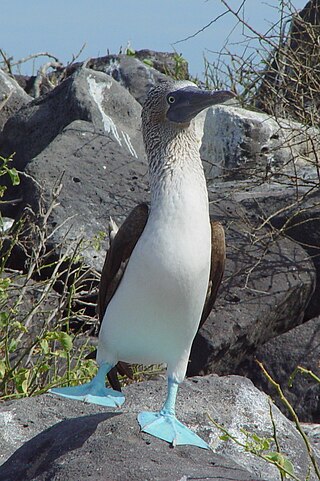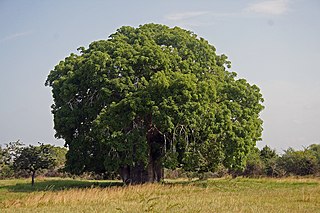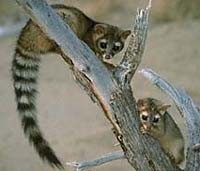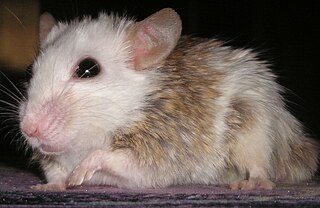
Armadillos are New World placental mammals in the order Cingulata. The Chlamyphoridae and Dasypodidae are the only surviving families in the order, which is part of the superorder Xenarthra, along with the anteaters and sloths. Nine extinct genera and 21 extant species of armadillo have been described, some of which are distinguished by the number of bands on their armor. All species are native to the Americas, where they inhabit a variety of different environments.

Weasels are mammals of the genus Mustela of the family Mustelidae. The genus Mustela includes the least weasels, polecats, stoats, ferrets, and European mink. Members of this genus are small, active predators, with long and slender bodies and short legs. The family Mustelidae, or mustelids, is often referred to as the "weasel family". In the UK, the term "weasel" usually refers to the smallest species, the least weasel (M. nivalis), the smallest carnivoran species.
Genus is a taxonomic rank used in the biological classification of living and fossil organisms as well as viruses. In the hierarchy of biological classification, genus comes above species and below family. In binomial nomenclature, the genus name forms the first part of the binomial species name for each species within the genus.

Otters are carnivorous mammals in the subfamily Lutrinae. The 13 extant otter species are all semiaquatic, aquatic, or marine, with diets based on fish and invertebrates. Lutrinae is a branch of the Mustelidae family, which also includes weasels, badgers, mink, and wolverines, among other animals.

Columbidae is a bird family consisting of doves and pigeons. It is the only family in the order Columbiformes. These are stout-bodied birds with short necks and short slender bills that in some species feature fleshy ceres. They primarily feed on seeds, fruits, and plants. The family occurs worldwide, but the greatest variety is in the Indomalayan and Australasian realms.

Aster is a genus of perennial flowering plants in the family Asteraceae. Its circumscription has been narrowed, and it now encompasses around 170 species, all but one of which are restricted to Eurasia; many species formerly in Aster are now in other genera of the tribe Astereae. Aster amellus is the type species of the genus and the family Asteraceae.

Echinacea is a genus of herbaceous flowering plants in the daisy family. It has ten species, which are commonly called coneflowers. They are found only in eastern and central North America, where they grow in moist to dry prairies and open wooded areas. They have large, showy heads of composite flowers, blooming in summer. The generic name is derived from the Greek word ἐχῖνος, meaning "hedgehog", due to the spiny central disk. These flowering plants and their parts have different uses. Some species are cultivated in gardens for their showy flowers. Two of the species, E. tennesseensis and E. laevigata, were formerly listed in the United States as endangered species; E. tennesseensis has been delisted due to recovery and E. laevigata is now listed as threatened.

Primula is a genus of herbaceous flowering plants in the family Primulaceae. They include the primrose, a familiar wildflower of banks and verges. Other common species are P. auricula (auricula), P. veris (cowslip), and P. elatior (oxlip). These species and many others are valued for their ornamental flowers. They have been extensively cultivated and hybridised. Primula are native to the temperate Northern Hemisphere, south into tropical mountains in Ethiopia, Indonesia, and New Guinea, and in temperate southern South America. Almost half of the known species are from the Himalayas.

Starlings are small to medium-sized passerine birds in the family Sturnidae. The Sturnidae are named for the genus Sturnus, which in turn comes from the Latin word for starling, sturnus. Many Asian species, particularly the larger ones, are called mynas, and many African species are known as glossy starlings because of their iridescent plumage. Starlings are native to Europe, Asia, and Africa, as well as northern Australia and the islands of the tropical Pacific. Several European and Asian species have been introduced to these areas, as well as North America, Hawaii, and New Zealand, where they generally compete for habitats with native birds and are considered to be invasive species. The starling species familiar to most people in Europe and North America is the common starling, and throughout much of Asia and the Pacific, the common myna is indeed common.

A booby is a seabird in the genus Sula, part of the family Sulidae. Boobies are closely related to the gannets (Morus), which were formerly included in Sula.

The Lamniformes are an order of sharks commonly known as mackerel sharks. It includes some of the most familiar species of sharks, such as the great white, as well as more unusual representatives, such as the goblin shark and megamouth shark.

Chevrotains, or mouse-deer, are diminutive, even-toed ungulates that make up the family Tragulidae, and are the only living members of the infraorder Tragulina. The 10 extant species are placed in three genera, but several species also are known only from fossils. The extant species are found in forests in South and Southeast Asia; a single species, the water chevrotain, is found in the rainforests of Central and West Africa. They are solitary, or live in loose groupings or pairs, and feed almost exclusively on plant material. Chevrotains are the smallest hoofed mammals in the world. The Asian species weigh between 0.7 and 8.0 kg, while the African chevrotain is considerably larger, at 7–16 kg (15–35 lb). With an average length of 45 cm (18 in) and an average height of 30 cm (12 in), the Java mouse-deer is the smallest surviving ungulate (hoofed) mammal, as well as the smallest artiodactyl. Despite their common name of "mouse deer", they are not closely related to true deer.

Adansonia is a genus made up of eight species of medium-to-large deciduous trees known as baobabs. They are placed in the Malvaceae family, subfamily Bombacoideae. They are native to Madagascar, mainland Africa, and Australia. The trees have also been introduced to other regions such as Asia. The generic name honours Michel Adanson, the French naturalist and explorer who described Adansonia digitata. The baobab is also known as the "upside down tree", a name that originates from several myths. They are among the most long-lived of vascular plants and have large flowers that are reproductive for a maximum of 15 hours. The flowers open around dusk, opening so quickly that movement can be detected by the naked eye, and are faded by the next morning. The fruits are large, oval to round and berry-like and hold kidney-shaped seeds in a dry, pulpy matrix.

Bassariscus is a genus in the family Procyonidae. There are two extant species in the genus: the ringtail or ring-tailed cat and the cacomistle. Genetic studies have indicated that the closest relatives of Bassariscus are raccoons, from which they diverged about 10 million years ago in the Tortonian Age of the Miocene. The two lineages of Bassariscus are thought to have separated after only another two million years, making it the extant procyonid genus with the earliest diversification. Later diversification in the genus in the Pliocene and Pleistocene saw the emergence of two extinct species, Bassariscus casei and Bassariscus sonoitensis, respectively. Due to the more digitigrade stance of their legs compared to the plantigrade stance of other members of Procyonidae, some taxonomies place the genus as a separate family, Bassaricidae.. The name is a Greek word for fox ("bassaris") with a Latinized diminutive ending ("-iscus"). The genus was named by Elliott Coues in 1887, having previously been described by Lichtenstein in 1830 under the name Bassaris. Coues proposed the word "bassarisk" as the English term for animals in this genus. Its habitat includes semi-arid areas in the southwestern United States, the whole of Mexico, as well as moist tropical forests in Central America.

Grevillea, commonly known as spider flowers, is a genus of about 360 species of evergreen flowering plants in the family Proteaceae. Plants in the genus Grevillea are shrubs, rarely trees, with the leaves arranged alternately along the branches, the flowers zygomorphic, arranged in racemes at the ends of branchlets, and the fruit a follicle that splits down one side only, releasing one or two seeds.
Rubivirus is a genus of viruses. It contains three species.

Mastomys is a genus of rodent in the family Muridae endemic to Africa. It contains eight species:

Pristimantis is a very large genus of frogs distributed in the southern Caribbean islands and in Central and South America from Honduras to northern Argentina and southern Brazil. With 596 described species, the genus had more species than any other genus of vertebrate animals. Many of these species genus are endemic to the Northwestern Andean montane forests ecoregion in north-western South America.

Salvia is the largest genus of plants in the sage family Lamiaceae, with nearly 1000 species of shrubs, herbaceous perennials, and annuals. Within the Lamiaceae, Salvia is part of the tribe Mentheae within the subfamily Nepetoideae. One of several genera commonly referred to as sage, it includes two widely used herbs, Salvia officinalis and Salvia rosmarinus.

Picramniaceae is a small, mainly neotropical family of four genera Aenigmanu, Alvaradoa, Nothotalisia and Picramnia. The family is the only member of the order Picramniales. Members of the family were formerly placed in the family Simaroubaceae or misidentified as species in the family Sapindaceae, in the order Sapindales. The most recent standard classification of the Angiosperms distinguishes it as a separate family and order. It belongs to the malvids, one of the three groups that constitute the rosids.

















